Bigfoot (truck)
|
Bigfoot racing in Arizona | |
| Owner and driver information | |
|---|---|
| Owner | Bob Chandler |
| Driver(s) | Dan Runte, Rick Long, Ron Bachman, Rodney Tweedy, Nigel Morris, Alan Hartsock, Eric Meagher, Eric Tack, Keith Sturgeon, Jerry Dalton, Jim Heineman, Jim Kmiec, Brian Bertoletti, Amber Walker |
| Home city | Pacific, Missouri |
| Truck information | |
| Year created | 1975 |
| Body style | Ford F-Series |
| Transmission | Ford C6 transmission, Abruzzi 2-Speed |
| Tires | 48 inch, 66 inch, and 120 inch Firestone |
Bigfoot, built in 1975 and debuted in 1979, is regarded as the original monster truck.[1] Other trucks with the name "Bigfoot" have been introduced in the years since, and it remains a well-known monster truck moniker in the United States. Bigfoot 4×4, Inc. is owned and operated by its creator, Bob Chandler.
Early history
A former construction worker from the St. Louis, Missouri area, Chandler began building the first Bigfoot in 1975, using the Chandler family's 1974 F-250 four-wheel drive and found that automotive shops in the Midwest generally did not carry the parts needed to repair his frequently-wrecked 4×4. To remedy this problem, Chandler and his wife Marilyn, along with friend Jim Kramer, opened a shop called Midwest Four Wheel Drive and Performance Center in Ferguson, Missouri. The shop moved to Hazelwood, Missouri in 1984, which remained as Bigfoot's headquarters until 2015 when the headquarters was relocated to Pacific.
The truck's first attention-grabbing modification came when Chandler heard of an idea proposed to the US Army of making steering capable on both axles of their four-wheeled vehicles, so that in the event of breakage in the front axle, it could simply be switched with the rear axle and held straight with a pin so that the vehicle could resume regular use with steering. Chandler decided to test that theory on his truck, but in addition would actually enable steering on the rear axle. The end result was an innovation in automotive technology – the "4×4×4", or a vehicle with four wheels, four-wheel-drive, and four-wheel-steering.
In 1979, Chandler started making appearances at truck and tractor pulls, as well as car shows, with his newly christened "Bigfoot" to show off the truck's capabilities as well as to promote his shop. The truck's growing popularity led to its appearance in the 1981 Gus Trikonis film Take This Job and Shove It (which also features the early monster truck USA-1 credited under a different name).
Chandler's next experiment would not only change his life and fortune, it would change the motorsports world forever. In 1981, Chandler obtained permission from a local farmer to place two dilapidated cars in his field, so that Chandler could videotape himself crushing the cars with Bigfoot as a joke. When Chandler began playing the video in his shop, a man promoting a motorsports event in Columbia, Missouri asked him to duplicate the stunt in front of a crowd. After initial hesitation because of the destructive image it would convey, Chandler eventually agreed to perform at the event in April of the following year in what is believed to be the first public car crush. Later that year, a second Bigfoot (built to help meet the steadily rising demand to see the vehicle) received more major media attention by crushing cars at the Pontiac Silverdome in Pontiac, Michigan. In 1983, Bigfoot began receiving sponsorship from Ford Motor Company, a relationship which continued until 2005.
By 1984, many truck owners around the country had taken to imitating Chandler's template of outfitting their vehicles with tires standing 66 inches tall, with some trucks sporting even larger tires. Promoters of truck and tractor pulls, such as SRO Motorsports (later the United States Hot Rod Association) and Golden State Promotions, noticed the exploding popularity of the giant trucks and began booking several to crush cars at their events, with the eventual result being the advent of side-by-side, drag-racing style car crushing events. A popular example of the early days of monster truck racing is portrayed in the 1986 home video release Return of the Monster Trucks, which involves a truck pull, car crushing, and mud bogging all in the same course. That event, held in the Louisiana Superdome, was won by Bigfoot, as well as most of the events it was entered into in the mid-1980s. By this point, Chandler had already built an entire fleet of "Bigfoot" trucks to accommodate the vast demand for his vehicle, which remained as the most popular and marketable monster truck despite the large number of imitators. In 1987, Chandler added to his innovations by founding the Monster Truck Racing Association, which remains today as the chief voice in monster truck safety.
Another form of competition Chandler faced was the physical size of the competition. Many truck owners had taken to calling their vehicles the "world's largest monster truck", so Chandler outfitted his "Bigfoot 4" vehicle with 10-foot-tall tires he had purchased from a junkyard owner in Seattle, for $1000. The tires had been previously used by the US Army in Alaska on their overland train in the 1950s. In 1986, Chandler built a new truck, "Bigfoot 5", specifically for the tires. Upon its public debut in Indianapolis, Indiana, the truck immediately took the title of the "world's tallest, widest, and heaviest monster truck" and was eventually given official recognition of the title by the Guinness Book of Records in 2002. With a second set of 10-foot-tall tires attached, the truck stands 15 feet, six inches high, measures 20 feet, 5 inches across, and weighs over 38,000 pounds.
Racing history
The fledgling all-sports television network ESPN also took note of the popularity of monster trucks in the 1980s and began showing events promoted by the United States Hot Rod Association and TNT Motorsports on a regular basis. With the frequent broadcasts of monster truck races, the next logical step was to create a championship series of monster truck races. TNT began the first recognized series in 1988, and was dominated by Bigfoot for much of the season. However, upstart rookie Rod Litzau, driving the USA-1 truck, gained momentum and passed Bigfoot in the standings going into the last weekend of the season in Louisville, Kentucky. With the way the points system and elimination brackets had been structured, Bigfoot (driven by Rich Hooser) and USA-1 met in the semifinal round with USA-1 clinching the points championship if it beat Bigfoot. USA-1 won the race in spectacular fashion, rolling over in the process, and took the championship. After losing the championship, the Bigfoot team made the decision to shift their focus less on competition and more on research and development in 1989, as well as running frequent events for the USHRA and USA Motorsports and a limited TNT Schedule.
During this time, Chandler began working with computer-aided design (CAD) programs, and using technology he had learned from professional off-road racing, designed a tubular frame for his next Bigfoot truck, along with a suspension system sporting two feet of travel. This innovation allowed Bigfoot to possess four times as much suspension travel as those used by nearly all previous monster trucks. Chandler would be awarded a patent for his designs. After testing the vehicle for three months, driver Andy Brass debuted the eighth incarnation of Bigfoot, with the new frame and suspension, in late 1989. It officially made its debut at the Indiana State Fairgrounds in Indianapolis, Indiana at the Four Wheel and Off Road Jamboree in a special 5,000th show for Bigfoot (where every Bigfoot vehicle gathered in one place for the first time). It made its debut in competition at a USHRA race in the Astrodome in Houston, Texas, reaching the final round of competition before rolling over against Jack Willman's Taurus.
The following year, after running the USHRA races in Anaheim, California, and Pontiac, Michigan, the truck would debut on the TNT Motorsports Monster Truck Challenge points circuit in Memphis, Tennessee, and would find the Bigfoot No. 8 chassis briefly banned from the circuit on April 5, 1990, due to a rule clarification that only allowed leaf, coil, and coilover suspensions to be run (Bigfoot No. 8 ran nitrogen shocks). Although TNT stated that safety was the primary reason for the clarification, they also admitted that another reason was that Bigfoot No. 8 was simply too technologically advanced and was upsetting the competitive balance of the series. Former BMX racer John Piant, piloting "Bigfoot #4" raced in place of No. 8 from Dallas, Texas to Myrtle Beach, South Carolina. Andy Brass did drive Bigfoot No. 4 to victory at the Louisville Motor Speedway. Bigfoot No. 8 returned to the TNT circuit after the temporary ban had been lifted. Chandler also took legal action against TNT. Team Bigfoot ended up winning 24 events that season and took the 1990 TNT points championship over Greg Holbrook in Gary Cook's Equalizer and Gary Porter's Carolina Crusher, the first racing championship for the Bigfoot team. Also that year, Piant took the Special Events Triple Crown Championship, in addition to placing third in the USHRA's new point series. After not winning any championships in 1991, Team Bigfoot would go on a 12-year stretch from 1992 to 2003 of winning at least one championship a year, taking a total of 16 series championship victories during that span. The most notable of Team Bigfoot's recent series championship victories came in 2007, when Bigfoot No. 16 and driver Dan Runte won the first championship series held by the Major League of Monster Trucks. As of 2016, Team Bigfoot now a total of 41 series championships.[2]
Present day
Bigfoot continues to be in demand. Sponsorships with Firestone, Summit Racing and Vi-Cor have kept Bigfoot in the spotlight in recent years. A partnership with Microsoft led to several PC and console video games starring Bigfoot. Recently, the trucks have been featured in the mobile app "Monster Truck Destruction". Always seeking to further innovate the sport, Chandler created monster truck racing's first open-invitation point series, ProMT, in 2000, which still in existence today, albeit only in Europe.
As for closed-invitation promotions, Bigfoot ceased running events for the USHRA's Monster Jam series in 1998 (due to a dispute involving Team Bigfoot's usage of video footage and pictures, among other, less-well-known reasons) and has not returned since. Bigfoot appeared frequently for USA Motorsports and Motorsports Entertainment Group until both of those companies were purchased by the USHRA's parent company at the time, PACE Motorsports.
Bigfoot still races for the Special Events Promotion Company (which hosted many ProMT races before ProMT ceased sanctioning races in North America after 2004), Chris Arel Motorsports, Toughest Monster Truck Tour, Monster Nation, Monster X Tour, Checkered Flag Promotions, and many others. In 2007 the BIGFOOT team briefly brought back Midwest 4 Wheel Drive at the Home of BIGFOOT in Hazelwood, Missouri.
As a token of appreciation for fathering a brand new form of motorsport that remains widely popular today, the Missouri Sports Hall of Fame inducted Chandler into their Class of 2006.
In May 2006, Bigfoot signed former professional wrestler and Monster Jam driver Debrah Miceli. Miceli drove the "Bigfoot 10" chassis until the end of the 2007 Major League of Monster Trucks (MLMT) season. Miceli now drives Madusa for Feld Motorsports.
In December 2005, Bigfoot's sponsorship with Ford ended, though was not announced officially until 2007.
In July 2010, it was announced Major League Baseball would provide sponsorship to Bigfoot. For the first time since the first Bigfoot truck was built in 1974, the Bigfoot 10 chassis would now have a Chevrolet Silverado body due to their partnership with MLB.[3][4] In March 2012, Bigfoot formed a partnership with Robby Gordon to promote both his SPEED Energy Drink and his new Stadium Super Trucks racing series. For the partnership, a chassis initially built for Gordon himself was dubbed Bigfoot 19. Despite a promotional picture depicting the body as being a Ford, this truck would also compete with a highly modified Silverado body.[5]
In November 2011, Bob Chandler was inducted into the International Monster Truck Museum Hall of Fame with its inaugural class. Former driver Jim Kramer was inducted into the second class the following year.
In 2013, Bob Chandler was inducted into the Off-Road Motorsports Hall of Fame.
Other Bigfoot facts
- There is no Bigfoot 13. After Bigfoot 12 was constructed, it was decided that the next Bigfoot truck to be built would be called Bigfoot 14, due to superstition about the number 13. However, Race Rock Vegas Bigfoot, a shell version of a rebuilt Bigfoot 7 at Race Rock Orlando, is now commonly known as Bigfoot 13.
- In 1998, Bigfoot 9 took a tour of Brazil. When it was due to return to the United States, however, a customs incident in Brazil caused the truck to be confiscated.[6] It is currently used by an independent company in Brazil, and legal obstacles have made it all but impossible for the truck to return to the United States.
- Bigfoot got its name when Bob Chandler asked friend Ron Magruder why he was breaking so many parts on his truck. Magruder responded, "It's because of your big foot."[7]
- Dan Runte, driving Bigfoot 14, set a then world monster truck long jump record on September 11, 1999 in Smyrna, Tennessee, when he jumped the truck a total of 202 feet, clearing a 727 jetliner in the process. After Joe Sylvester in Bad Habit took the record in 2012 (then at 208 feet), Dan Runte once again reclaimed the record in Bigfoot 18 with a jump of 214 feet 8 inches in Indianapolis, Indiana, on September 16, 2012.
- Dan Runte also possesses the 1/8-mile speed record for a monster truck. He piloted Bigfoot 16 to a speed of 86.56 mph in Norwalk, Ohio, on September 25, 2010.
- In 2003, Nigel Morris partnered with Bob Chandler to build Bigfoot 17, the first Bigfoot to compete exclusively outside of the United States. Bigfoot 17 competes primarily in the United Kingdom.
- Bigfoot has several alternative names and identities for their trucks when two of their trucks are scheduled at a show. Among these have been "Summit Bigfoot", "Power Wheels Bigfoot", "Tonka", "Xbox", "WildFoot" and "Snake Bite". Currently, a Vi-Cor Sponsored truck, known unofficially as "Bigfoot Bessie", competes with a cow-themed paint scheme.
- Snake Bite (using Bigfoot 4's chassis) was originally driven by Gene Patterson, under the pseudonym of Colt Cobra. He wore a mask to hide his identity and came from the fictional town of Cobra Creek, Colorado. Eric Meagher became Colt Cobra in 1993 (now with Bigfoot 8's chassis) when Gene drove Bigfoot No. 10 to second place behind Andy Brass in Bigfoot #11. Dan Runte drove it as Ricky Rattler for a short time, but Ricky also came from Cobra Creek, Colorado. Since 1997, a regular Bigfoot driver under his own name has been driving Snake Bite. Recently there is a new pseudonym named Peter Python that debuted at the Midwest Four-Wheel Drive Open house for 2009. For that show it was portrayed by Larry Swim.
- There was an animated cartoon featuring the Bigfoot Monster Truck, Bigfoot and the Muscle Machines in the 1980s. The truck has been frequently licensed for use in toys.
- Bigfoot is referenced in two different episodes of Futurama.
- A video game for the Nintendo Entertainment System of the same name was released in 1990 by Acclaim Entertainment.
- Bigfoot was one of the main characters of the animated series, The Power Team. It (or "he" in the show) was added to advertise the NES game above.
- A Discovery Kids TV series called Bigfoot Presents: Meteor and the Mighty Monster Trucks was released in 2006.
- A new "Ms. Bigfoot" debuted in April 2010, driven by Amber Walker.[8]
Legacy
Bigfoot was listed by Hot Rod magazine as one of 100 most influential vehicles in the history of hot rodding for its February 2009 issue, it was ranked 69th.[9]
List of Bigfoot vehicles
The following is a list of all the vehicles built or owned by Bigfoot 4×4, Inc., and their current status. Notice that there is no Bigfoot #13; Bigfoot #13, just like Grave Digger #13, was skipped due to superstition regarding the number 13.
| Name | Built | Driver | Details | Photo |
|---|---|---|---|---|
| Bigfoot 1 | 1975 | N/A | In 1974, Bob Chandler bought a stock 1974 F-250 pickup truck.[10] In the next few years, Chandler made modifications to the truck to increase its horsepower and off-road capabilities, while promoting the Midwest 4 Wheel Drive Center business. The truck was used in local truck and tractor pulls, mud runs, and other off-road events.[11] In 1979, the 1974 front clip was replaced with a 1979 front clip that flipped forward to allow greater access to the engine and rear steering was introduced.[12] That same year, Bigfoot 1 made its first paid public appearance in Denver, Colorado. In 1981, Bigfoot 1 made the first monster truck car crush. That same year, Bigfoot 1 was featured in the film Take This Job and Shove It. In 1982, Bigfoot 1 was the first monster truck to crush cars in front of an audience. In March 1983, Bigfoot 1 performed in front of 72,000 fans in the largest single day monster truck event at the Pontiac Silverdome.[13] It was in competition until 1987. Currently used as a display vehicle, it resides at the Bigfoot 4 × 4 store in St. Louis. | 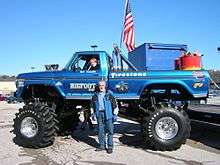 Bigfoot #1, with Jim Kramer. 12-5-2009 |
| Bigfoot 2 | 1982 | N/A | Completed in the fall of 1982. Bigfoot 2 was the first monster truck to use 66-inch tall tires, the standard monster truck tire used from that point forward. The truck raced a paddle steamer on the Chattahoochee River in Columbus, Georgia in 1985.[14] Modified in 1992 for the purpose of giving fans monster truck rides in the bed of the vehicle, and renamed SafariFoot. Sold in 2000 to an independent owner. The truck is currently named "FloodPro". | 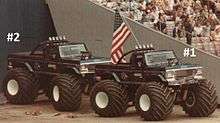 1 and 2 in St. Louis. Date unknown. |
| Bigfoot 3 | 1983 | N/A | Built in 66 days in the fall of 1983 and made its debut in January 1984 at the Pontiac Silverdome. Received same ride-truck modifications as Bigfoot 2 in 1992. Donated to E.M.T. Financial Fund in 2000.[15] Owned by Steve Ford from 2007–2014. It was renamed Legend and used as an exhibition vehicle.[16] In Spring 2014, the old Bigfoot 3 sold to Eli Mann and Bethany Corriveau of Bethel, Maine. In Winter 2014-15, it will be restored back to its 1984 sheet metal. It will retain all modifications to its running gear that had been updated in 1987 and 1991. Used in the movie Police Academy 2: Their first assignment. |  Bigfoot III in St. Louis. Date unknown. |
| Bigfoot 4 | 1984 | N/A | This truck debuted on July 31, 1984 at the grand opening of the new Bigfoot headquarters in Hazelwood, Missouri. Bigfoot 4 made its on-track debut on September 14, 1984 at the Riverside Centroplex in Baton Rouge, Louisiana. This truck won the first ever side-by-side monster truck race over an obstacle course in January 1986 at the Louisiana Superdome.[17] This truck was the first of the Bigfoot monster trucks to roll over, which occurred in Murray, Kentucky in 1986.[18] In April 1991, Bigfoot 4 became the first monster truck to have a 3-D concept body, and was redesigned as Snake Bite.[19] The final competition for the truck was February 1998 at the Worcester's Centrum Centre in Worcester, Massachusetts. From 1998–2006, Bigfoot 4 was used as a full-time display truck.[20] The truck was sold in 2006 to a private customer in Missouri and now has the name "Massive Machine". | .jpg) Bigfoot IV in St. Louis. Date unknown. |
| Ms. Bigfoot/Bigfoot Ranger | 1985 | N/A | This truck was the last Bigfoot truck to be completed from a factory production pickup truck. The truck produced 1,000 horsepower from a 571 cubic inch supercharged aluminum hemi engine. Ms. Bigfoot debuted at Jack Murphy Stadium in San Diego, California on July 4, 1985. Marilyn Chandler, wife of Bigfoot creator Bob Chandler, became the first female monster truck driver when she piloted Ms. Bigfoot. In 1987, the truck was redesigned as "Bigfoot Ranger." Bigfoot Ranger was the first Bigfoot truck to be sold.[21] In 1993, it was sold to Chandler Lloyd and was used to build "Lil Truck." | |
| Bigfoot Shuttle | 1985 | N/A | Built from an Aerostar minivan, it has the stock V6 engine. Nitrous oxide injection was added later.[22] Sold in 2002 to Jeff Halliday, a vice president at the official monster truck hall of fame, for private use. | |
| Bigfoot 5 | 1986 | N/A | Completed in the summer of 1986 and designed exclusively for use with 10 foot tall Firestone Tundra tires. Bigfoot 5 debuted at the 1986 Fall Jamboree in Indianapolis, and set the record for the tallest, widest, and heaviest pickup truck in the world.[23] Mostly used as a display vehicle at Bigfoot's headquarters. It started as a customer's truck, and was purchased a few years later. The original 1974 body was removed in 1989 and a current year was put in its place. The old body was placed on a waiting frame and used as a shop truck at the Bigfoot shop. The original body is now privately owned by Eli Mann, and is being restored. The truck resides at the St. Louis Bigfoot 4 × 4 store. | 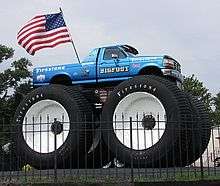 Bigfoot outside company Headquarters in Hazelwood, Missouri USA |
| Bigfoot 6 | 1986 | N/A | Built in the fall of 1986. At the Indiana State Fairgrounds in 1987, Bigfoot 6 set a record of jumping over 13 cars. The truck was featured in the 1989 film Police Academy 6: City Under Siege. During 1992 and 1993, Bigfoot 6 toured the United Kingdom, Ireland, Iceland, and other European countries. In 1993, Bigfoot 6 and driver Jim Greco completed 160 performances in 164 days in the United Kingdom. The truck was sold to a British promoter after a tour of Thailand in 1994.[24] | |
| Bigfoot Fastrax | 1987 | N/A | Purchased in 1988 and underwent extensive modifications.[25] M48 personnel carrier chassis with two Ford 460ci engines and C6 automatic transmissions. The body is the upper half of a fiberglass replica of a 1990 Aerostar. Mostly used as a display vehicle at Bigfoot's headquarters in Hazelwood. |
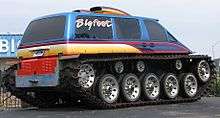 Bigfoot Fastrax |
| Bigfoot 7/Bigfoot Race Rock 1 | 1988 | N/A | Built in May 1988 specifically for the movie Road House. In the movie, Bigfoot 7 destroyed a new car showroom and crushed four new cars. That scene cost $500,000 and was shot in one take. It also was used in the movie Tango & Cash. Modified in 1995 to accommodate 10-foot-tall tires. The motor, transmission and steering were removed and the truck was sold to Race Rock Orlando.[26] After the restaurant went out of business, it was sold to Fun Spot USA in Kissimmee, Florida, where it currently resides.[27] | |
| Bigfoot 8 | 1989 | N/A | Built in mid-1989, Bigfoot 8 was the first Computer Aided Design (AutoCAD) designed truck. These "Stage III" trucks used a "radical tubular steel chassis design and patented cantilever suspension system."[28] In its first year in competition, driver Andy Brass and Bigfoot 8 won the 1990 TNT Monster Truck Challenge.[29] Used as a display truck and as a race truck if another cannot attend a scheduled date. Chassis built by Bigfoot 4x4. | |
| Bigfoot 9 | 1990 | N/A | Bigfoot 9 debuted on February 10, 1990 in Dayton, Ohio.[30] Seized by Brazilian customs; see above section. Chassis built by Bigfoot 4x4. | |
| Bigfoot 10 | 1992 | N/A | Bigfoot 10 debuted at the St. Louis Arena on January 31, 1992. This was Team Bigfoot's first mid-engine monster truck.[31] This truck won the 1992 Special Events Penda Points Series Championship and the 1999 Checkered Flag Points Championship.[32] Retired after a crash in Amarillo, Texas in February 2015.[33] Chassis built by Bigfoot 4x4. | 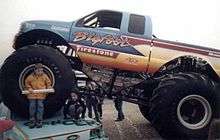 Bigfoot 10 near St. Louis. Date unknown. |
| Bigfoot 11 | 1992 | N/A | Bigfoot 11 debuted at the SEMA Show in Las Vegas in 1992. In 1993, the truck was redesigned as "Wildfoot", and went on to win the 1993 Special Events Penda Points Series and named 1993 MTRA Truck of the Year. The truck set a record in 1995 for world's longest monster truck jump at 117 feet. In 1999, Bigfoot 11 set a world record for monster truck wheelie length at 217 feet, 3 inches.[34] Bigfoot 11 was retired after a crash in Springfield, Illinois in June 2015. Chassis built by Bigfoot 4x4. | |
| Bigfoot 12 | 1993 | Ron Bachman | Built specifically as a display truck. Bigfoot 12 debuted on January 28, 1993 in conjunction with Super Bowl XXVII in Los Angeles.[35] Chassis built by Bigfoot 4x4. | |
| Bigfoot 14 | 1993 | Rick Long | This truck debuted at the Louisiana Superdome in January 1994. This truck won its first points championship in 1995 as Power Wheels Bigfoot.[36] On September 11, 1999, driver Dan Runte and Bigfoot 14 set a then-world record jump of a monster truck at 202 feet, breaking the previous record of 144 feet, 10 inches. The truck set the record by jumping over a Boeing 747 airplane at the Tennessee Aviation Days air show at the Smyrna, Tennessee Airport. Active race truck. Chassis built by Bigfoot 4x4. |  Bigfoot 14 in St. Louis. 10-16-2010 |
| Bigfoot 15 | 1994 | Josh Gibson | Active race truck. As of 2016, the truck is competing as Firestone Bigfoot. Bigfoot 15 debuted at the SEMA Show in Las Vegas, Nevada in November 1994. In 1997, the truck won its first championship competing as Snake Bite. The truck won championships in 2000, 2007, 2010, 2011, and 2012.[37] Chassis built by Bigfoot 4x4. | 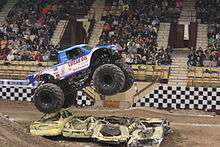 Bigfoot 15 jumping at the Brown County Arena in 2015 |
| Bigfoot Race Rock 2 | 1999 | N/A | Built specifically for permanent display at Race Rock restaurant in Las Vegas, Nevada. It was made to resemble 5 and 7. After the restaurant went out of business, it was sold to the Historic Auto Attractions museum in Roscoe, Illinois, where it currently resides.[38] | |
| Bigfoot 16 | 2007 | N/A | Completed in April 2007, Bigfoot 16 debuted at the Four Wheel and Off Road Jamboree in Springfield, Missouri. This was the first Bigfoot monster truck to have a 2-speed Abruzzi transmission rather than a 3-speed Ford C-6 transmission.[39] In its first year of competition, Bigfoot 16, driven by Dan Runte, won the Major League of Monster Trucks championship.[40] Retired after a crash in the fall of 2012 at the Indianapolis 4x4 Jamboree when piloted by Larry Swim. |  Bigfoot 16 in Jefferson City, Missouri. 8-2-2012 |
| Bigfoot 17 | 2003 | Nigel Morris | Active race truck. Built and operated by Nigel Morris, owner of L.A. Supertrux, Ltd., in a partnership with Bigfoot 4x4, Inc. Bigfoot 17 made its debut at Truckfest Peterborough on the May Bank Holiday in 2003.[41] The truck competes exclusively in Europe. |
 Monster truck Bigfoot 17 competing at the Monster Mania event at The Hop Farm Country Park on August 16, 2008 |
| Bigfoot 18 | 2011 | Larry Swim | Active race truck. As of 2016, the truck is competing as Firestone Bigfoot. Bigfoot 18 was completed in December 2011 and was the first Bigfoot truck to feature a desert trophy truck-style body. Dan Runte and the truck won the Toughest Monster Truck Tour Championship in its first year of race competition. In September 2012, Dan Runte and Bigfoot reclaimed the Guinness Book of Records title for world's longest monster truck jump at the 2012 Indianapolis 4x4 Jamboree. The truck jumped 214 feet, 8 inches to break Bad Habit's previous world record long jump.[42] Chassis built by Concussion Motorsports. | |
| Bigfoot 19 | 2012 | Darron Schnell | Active race truck. As of 2016, the truck is competing as Retro Racing Stripe Bigfoot. Bigfoot 19 was completed in September 2012. It is the first Bigfoot truck to make its debut overseas, doing so in Aruba in October 2012. Bigfoot 19 made its American debut in Cincinnati on December 29, 2012. This is the first Chevy-powered Bigfoot monster truck. The Retro Racing Stripe design was voted by fans during a contest during Bigfoot's 40th Anniversary in 2015.[43] This truck was originally owned by Robby Gordon, operated by Bigfoot 4x4 with Speed Energy sponsorship; see above. | |
| Bigfoot 20 | 2012 | N/A | Bigfoot 20 is the world's only electric monster truck. The truck is powered by an electric motor and 36 Odyssey batteries. Bigfoot 20 debuted at the SEMA Show in Las Vegas, Nevada on October 30, 2012. The truck made its first car crush on November 8, 2012.[44] Chassis built by Nigel Morris, driver of Bigfoot 17, in the UK. | |
| Bigfoot 21 | 2014 | Dan Runte | Active race truck. As of 2016, the truck is competing as Summit Racing Equipment Bigfoot. Bigfoot 21 was completed on December 24, 2014 and debuted in Southaven, Mississippi on January 9–10, 2015, winning a race and freestyle competition in its debut weekend. This truck uses "zoomie" headers that gives it "a very loud and unique sound as compared to other BIGFOOT trucks."[45] Chassis built by Concussion Motorsports. |
References
- ↑ http://bigfoot4x4.com/blog/the-history-of-bigfoot/
- ↑ http://bigfoot4x4.com/blog/team-bigfoot-championships/
- ↑ Zach Bowman. "Bigfoot monster truck defects from Ford to Chevy after more than 35 years". Autoblog. Retrieved June 24, 2015.
- ↑ Ben Wojdyla. "The New Bigfoot Wears A Bowtie". Jalopnik. Retrieved June 24, 2015.
- ↑ "A "BIG" Move for Robby Gordon & SPEED Energy – race-deZert.com". race-deZert.com. Retrieved June 24, 2015.
- ↑ http://bigfoot4x4.com/blog/bigfoot-9/
- ↑ "1977 2007 Anniversary Monster Trucks – 4Wheel & Off-Road Magazine". Four Wheeler. August 1, 2007. Retrieved June 24, 2015.
- ↑ "Amber Walker and Ms. Bigfoot: Little Lady With Very Big Dreams".
- ↑ "Top 100 Hot Rods That Changed the World". Hot Rod. January 29, 2008. Retrieved June 24, 2015.
- ↑ http://bigfoot4x4.com/blog/bob-chandler/
- ↑ http://bigfoot4x4.com/blog/the-history-of-bigfoot/
- ↑ http://bigfoot4x4.com/blog/bigfoot-1-the-original-monster-truck/
- ↑ http://bigfoot4x4.com/blog/bigfoot-1-the-original-monster-truck/
- ↑ http://bigfoot4x4.com/blog/bigfoot-2/
- ↑ http://bigfoot4x4.com/blog/bigfoot-3/
- ↑ https://web.archive.org/web/20160502032051/http://www.legendmonster.com/
- ↑ http://bigfoot4x4.com/blog/bigfoot-4b/
- ↑ http://bigfoot4x4.com/blog/bigfoot-4c/
- ↑ http://bigfoot4x4.com/blog/bigfoot-4d/
- ↑ http://bigfoot4x4.com/blog/bigfoot-4e/
- ↑ http://bigfoot4x4.com/blog/ms-bigfoot-bigfoot-ranger/
- ↑ http://bigfoot4x4.com/blog/bigfoot-shuttle/
- ↑ http://bigfoot4x4.com/blog/bigfoot-5/
- ↑ http://bigfoot4x4.com/blog/bigfoot-6/
- ↑ https://web.archive.org/web/19990420082237/http://www.bigfoot4x4.com/
- ↑ http://bigfoot4x4.com/blog/bigfoot-7/
- ↑ http://www.waymarking.com/waymarks/WMDKVV_Big_Foot_Monster_Truck_Fun_Spot_USA_Kissimmee_Florida
- ↑ http://bigfoot4x4.com/blog/the-history-of-bigfoot/
- ↑ http://bigfoot4x4.com/blog/the-history-of-bigfoot/
- ↑ http://bigfoot4x4.com/blog/bigfoot-9/
- ↑ http://www.roadandtrack.com/motorsports/news/a25554/photo-of-the-day-the-bigfoots-gather/
- ↑ http://bigfoot4x4.com/blog/bigfoot-10/
- ↑ http://bigfoot4x4.com/blog/news-2015-bigfoot-11-22/
- ↑ http://bigfoot4x4.com/blog/bigfoot-11/
- ↑ http://bigfoot4x4.com/blog/bigfoot-12/
- ↑ https://web.archive.org/web/19991012153408/http://bigfoot4x4.com/
- ↑ http://bigfoot4x4.com/blog/firestone-bigfoot/
- ↑ http://historicautoattractions.com/m/exhibit_worldofspeed_bigfoot.asp
- ↑ https://web.archive.org/web/20080112034834/http://www.bigfoot4x4.com/bf16.html
- ↑ http://bigfoot4x4.com/blog/team-bigfoot-championships/
- ↑ http://www.bigfoot4x4.co.uk/driverbio.asp
- ↑ http://bigfoot4x4.com/blog/firestone-bigfoot-2015/
- ↑ http://bigfoot4x4.com/blog/retro-racer-stripe-bigfoot/
- ↑ http://bigfoot4x4.com/blog/battery-powered-bigfoot/
- ↑ http://bigfoot4x4.com/blog/summit-racing-bigfoot/
External links
| Wikimedia Commons has media related to Bigfoot (truck). |
- Bigfoot #10 at Truckfest Scotland 2014
- "Bigfoot and SFX Motor Sports – 1 Year Later"
- UK Bigfoot
- Legend- Dedicated to Bob Chandler